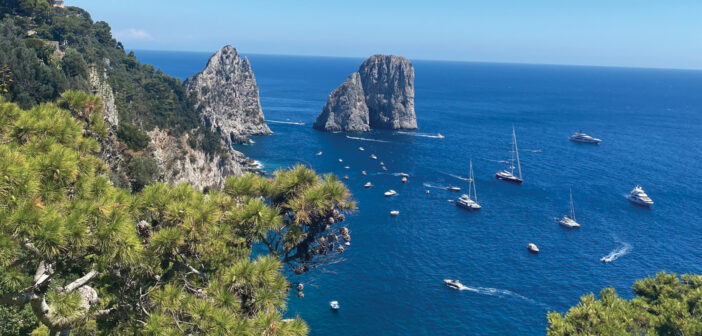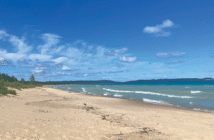Almost every time we go to Italy’s Amalfi Coast, we visit Capri. And every time we make that voyage, we regret it.
Capri has long been a luxurious retreat. Since Roman times, when emperors and their families, their courts and favored senators would travel south from the capitol to Naples and from there, board a boat to the small Mediterranean island. Now, as then, the Isle of Capri was an escape from the sweat and grime of summer in a metropolitan city … away from everyday life and responsibilities.
From the Amalfi Coast, Capri is a ferry ride or chartered boat trip away. For someone who doesn’t appreciate the rocking and rolling of the waves, this is a nightmare. I tend to forget how horrendous seasickness can be until I’m clenching my stomach, closing my eyes and pleading for death. My partner is always right out in the wind, drinking in the sight of the sapphire water, breathing the sea air, loving every moment. But even he regrets Capri.
When you weigh anchor in one of the island’s two harbours, the only option is up. Up, up, up. There are four areas of Capri: Marina Piccola, Marina Grande, Capri and Anacapri. The marinas are at sea level, but not worth visiting for longer than waiting for your boat to come back for you after seeing the other parts of the island. So, both quieter Anacapri and bustling Capri are up. Up, up, up. You can choose to hoof it, which is made very unpleasant by the unrelenting sunshine; or you can take a bus, which is also unpleasant but less so – unless like me, you have motion sickness.
While Anacapri and Capri are beautiful, charming little areas dotted with criminally priced restaurants and shopping, it can be difficult to see how the island would have been a break from Rome’s heat. It is unbelievably hot. And the farther up you climb on the island only brings you more forcefully into the sun’s heat. Pause for a cool drink and people-watching at one of the trattorias or bars? Expect to pay 3-4 times what you would anywhere else
on the coast. After perusing the menu, you may decide you’re not really as parched as you had originally thought.
It is certainly a swanky locale. Prada, Gucci, Tod’s, Louis Vuitton, Hermès, Alberta Ferretti – these are just some of the recognizable designer labels one can find on the island. It’s glamorous, upscale, blindingly posh; but also a bit pretentious. Most of the people walking around the island are dressed in thin, breathable Italian linen made from fine quality flax that looks incongruous with the type of luxury displayed in the shop windows.
Why do we dislike Capri so much? Mostly because it’s a long slog through the water and up the hills, only to arrive in a city that is nowhere near as welcoming as the rest of the coast. Italian hospitality, especially southern Italian hospitality, is present everywhere along the coast, from Sorrento to Salerno and every village and city in between; but Capri feels removed, aloof. It doesn’t have the same bonhomie of the rest of the coast. Instead, it feels overwhelmingly commercial … artificial in a way that prevents a visitor from becoming fully immersed in its beauty.
So, it is for these reasons that as we found ourselves alighting from one of the buses that transports tourists to the villages on the top of the island we were, once again, disappointed by Capri. And as we sipped our €16 Aperol Spritz, my partner said (as he has every time before), “let’s not do this again.” But somehow, I think we probably will.














